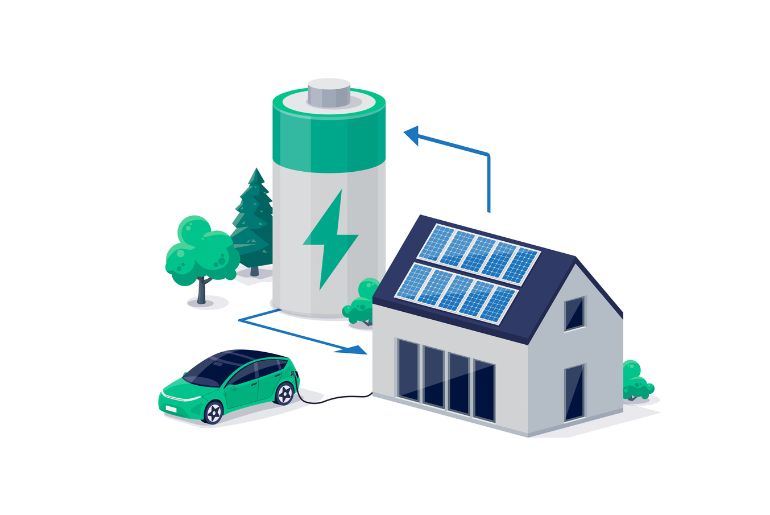In the evolving landscape of electric vehicles (EVs) and renewable energy integration, bi-directional charging technology is emerging as a game-changer. By enabling electric vehicles to not only draw power from the grid but also return energy back, bi-directional charging offers a myriad of economic and environmental benefits. This blog delves into how bi-directional charging can significantly lower energy costs, exploring its mechanisms, advantages, and future potential.
Understanding Bi-Directional Charging and its Energy Costs
What is Bi-Directional Charging?
Bi-directional charging, also known as vehicle-to-grid (V2G) technology, allows electric vehicles to both charge from and discharge to the power grid. This capability transforms EVs into mobile energy storage units that can provide electricity back to the grid or power other devices.
Mechanisms of Bi-Directional Charging
- Vehicle-to-Grid (V2G): Enables EVs to send stored energy back to the grid during peak demand times, supporting grid stability and reducing energy costs.
- Vehicle-to-Home (V2H): Allows EVs to power homes during outages or peak usage times, thus reducing reliance on grid electricity.
- Vehicle-to-Load (V2L): Provides power to external devices and appliances directly from the EV’s battery, offering versatile energy solutions.
Economic Benefits of Bi-Directional Charging for Energy Costs
Reducing Electricity Bills
Bi-directional charging enables EV owners to leverage time-of-use (TOU) pricing. By charging during off-peak hours when electricity rates are lower and discharging during peak hours, users can minimize their electricity bills.
Revenue Generation
- Energy Arbitrage: EV owners can sell excess electricity back to the grid during peak demand periods when prices are highest, generating additional income.
- Demand Response Programs: Participation in demand response programs can provide financial incentives to EV owners who allow their vehicles to supply power to the grid during high-demand periods.
Grid Support and Stability
By contributing to grid stability, bi-directional charging helps utilities avoid costly investments in additional infrastructure and peak power plants, translating to lower overall costs for consumers.
Technological Advancements Driving Cost Reduction
Advances in Battery Technology
Improvements in battery energy density, efficiency, and lifespan reduce the cost of bi-directional charging systems. Enhanced battery management systems (BMS) optimize charge and discharge cycles, further lowering operational costs.
Smart Grid Integration
Bi-directional charging is integral to smart grid technology, which uses advanced sensors and communication systems to manage electricity more efficiently. This synergy enhances the distribution and reduces waste, leading to cost savings.
Interoperability and Standardization
The development of standardized protocols and interoperable systems facilitates seamless integration of bi-directional charging with existing grid infrastructure, reducing installation and maintenance costs.
Environmental and Social Impact
Reducing Carbon Footprint
Bi-directional charging promotes the use of renewable energetic sources by storing excess green energy and returning it to the grid, thereby reducing reliance on fossil fuels and lowering greenhouse gas emissions.
Enhancing Energy Security
By decentralizing energy storage and distribution, bi-directional charging enhances energy security and resilience, particularly in regions prone to power outages and natural disasters.
Challenges and Solutions
Infrastructure Development
- Current Challenges: Limited availability of bi-directional charging stations and integration with the existing grid infrastructure pose significant challenges.
- Solutions: Investment in infrastructure development, government incentives, and partnerships between automotive and energetic sectors can accelerate the deployment of bi-directional charging networks.
Battery Degradation Concerns
- Current Challenges: Frequent charging and discharging cycles can accelerate battery wear and reduce lifespan.
- Solutions: Advanced battery management systems (BMS) and innovative battery technologies, such as solid-state batteries, can mitigate degradation and enhance longevity.
Future Prospects and Innovations
Integration with Renewable Energy
Bi-directional charging is poised to play a critical role in the integration of renewable energy sources. By providing flexible and scalable energy storage solutions, it supports the transition to a sustainable energy future.
Policy and Regulatory Support
Government policies and regulatory frameworks that incentivize bi-directional charging adoption and investment in infrastructure will be crucial for its widespread implementation.
Technological Innovations
Ongoing research and development in power electronics, battery technologies, and smart grid solutions will continue to enhance the efficiency, reliability, and affordability of bi-directional charging systems.
Conclusion: A Path to Sustainable and Cost-Effective Energy
Bi-directional charging represents a pivotal advancement in the intersection of electric mobility and smart grid technology. By enabling electric vehicles to act as both consumers and providers of electricity, it offers a multifaceted approach to lowering energy costs, enhancing grid stability, and promoting environmental sustainability. As technology advances and infrastructure expands, bi-directional charging is set to become a cornerstone of the modern energy ecosystem, driving significant economic and environmental benefits for consumers and society at large.

